The Spatial Variation of Acoustic Water Column Data and Its Relationship with Reef-Associated Fish Recorded by Baited Remote Underwater Stereo-Videos off the Western Australia Coast
Abstract
:1. Introduction
2. Materials and Methods
2.1. Study Area
2.1.1. Cockburn Sound
2.1.2. Ningaloo Marine Park
2.2. Data Acquisition
2.2.1. Singlebeam Echosounder
2.2.2. Baited Remote Underwater Stereo-Video Cameras
2.2.3. Data Collection in Cockburn Sound
2.2.4. Data Collection in Ningaloo Marine Park
2.3. Data Analysis
2.3.1. Postprocessing of the Singlebeam Echosounder Data
Nautical Area Scattering Coefficient
2.3.2. Postprocessing of the Stereo-BRUV Data
2.3.3. Singlebeam Echosounder vs. Stereo-BRUVs
3. Results
3.1. Cockburn Sound
3.1.1. Spatial Distribution of Acoustic Backscatter from Singlebeam Echosounder
3.1.2. Spatial Distribution of Relative Biomass from Stereo-BRUVs
3.1.3. Singlebeam Echosounder vs. Stereo-BRUVs
Benthic Habitats
3.2. Ningaloo Marine Park
3.2.1. Spatial Distribution of Acoustic Backscatter from Singlebeam Echosounder
3.2.2. Spatial Distribution of Relative Biomass from Stereo-BRUVs
3.2.3. Singlebeam Echosounder vs. Stereo-BRUVs
Benthic Habitats
4. Discussion
4.1. Cockburn Sound
4.2. Ningaloo Marine Park
4.3. Limitations of the Study
4.3.1. Cockburn Sound
4.3.2. Ningaloo Marine Park
4.3.3. Singlebeam Echosounder vs. Stereo-BRUVs
5. Conclusions
Supplementary Materials
Author Contributions
Funding
Institutional Review Board Statement
Informed Consent Statement
Data Availability Statement
Conflicts of Interest
References
- Goldman, B.; Talbot, F.H.; Jones, O.; Endean, R. Aspects of the ecology of coral reef fishes. Biol. Geol. Coral Reefs 1976, 3, 125–154. [Google Scholar]
- Cole, A.J.; Pratchett, M.S.; Jones, G.P. Diversity and functional importance of coral-feeding fishes on tropical coral reefs. Fish Fish. 2008, 9, 286–307. [Google Scholar] [CrossRef]
- Reaka-Kudla, M.L. The global biodiversity of coral reefs: A comparison with rain forests. Biodivers. II Unders. Prot. our Biol. Resour. 1997, 2, 551. [Google Scholar]
- Veron, J.E.N.; Hoegh-Guldberg, O.; Lenton, T.M.; Lough, J.M.; Obura, D.O.; Pearce-Kelly, P.; Sheppard, C.R.C.; Spalding, M.; Stafford-Smith, M.G.; Rogers, A.D. The coral reef crisis: The critical importance of. Mar. Pollut. Bull. 2009, 58, 1428–1436. [Google Scholar] [CrossRef] [PubMed]
- Friedlander, A.M.; Brown, E.K.; Jokiel, P.L.; Smith, W.R.; Rodgers, K.S. Effects of habitat, wave exposure, and marine protected area status on coral reef fish assemblages in the Hawaiian archipelago. Coral Reefs 2003, 22, 291–305. [Google Scholar] [CrossRef]
- Mora, C.; Andrèfouët, S.; Costello, M.J.; Kranenburg, C.; Rollo, A.; Veron, J.; Gaston, K.J.; Myers, R.A. Coral Reefs and the Global Network of Marine Protected Areas. Science 2006, 312, 1750–1751. [Google Scholar] [CrossRef] [PubMed]
- McClanahan, T.R.; Marnane, M.J.; Cinner, J.E.; Kiene, W.E. A Comparison of Marine Protected Areas and Alternative Approaches to Coral-Reef Management. Curr. Biol. 2006, 16, 1408–1413. [Google Scholar] [CrossRef] [Green Version]
- Logan, J.M.; Young, M.A.; Harvey, E.S.; Schimel, A.C.G.; Ierodiaconou, D. Combining underwater video methods improves effectiveness of demersal fish assemblage surveys across habitats. Mar. Ecol. Prog. Ser. 2017, 582, 181–200. [Google Scholar] [CrossRef]
- Cappo, M.; Harvey, E.; Malcolm, H.; Speare, P. Potential of video techniques to monitor diversity, abundance and size of fish in studies of marine protected areas. Aquat. Prot. Areas What Works Best How Do We Know 2003, 1, 455–464. [Google Scholar]
- Zenone, A.M.; Burkepile, D.E.; Boswell, K.M. A comparison of diver vs. acoustic methodologies for surveying fishes in a shallow water coral reef ecosystem. Fish. Res. 2017, 189, 62–66. [Google Scholar] [CrossRef]
- Reighard, J. The Photography of Aquatic Animals in Their Natural Environment; US Government Printing Office: Michigan, MI, USA, 1908.
- Pelletier, D.; Leleu, K.; Mou-Tham, G.; Guillemot, N.; Chabanet, P. Comparison of visual census and high definition video transects for monitoring coral reef fish assemblages. Fish. Res. 2011, 107, 84–93. [Google Scholar] [CrossRef] [Green Version]
- Cappo, M.; Speare, P.; De’ath, G. Comparison of baited remote underwater video stations (BRUVS) and prawn (shrimp) trawls for assessments of fish biodiversity in inter-reefal areas of the Great Barrier Reef Marine Park. J. Exp. Mar. Biol. Ecol. 2004, 302, 123–152. [Google Scholar] [CrossRef]
- Ellis, D.M.; Demartini, E.E. Evaluation of a video camera technique for indexing abundances of juvenile pink snapper, Pristimomoides filamentosus, and other Hawaiian insular shelf fishes. Fish. Bull. 1995, 93, 67–77. [Google Scholar]
- Davison, P.C.; Koslow, J.A.; Kloser, R.J. Acoustic biomass estimation of mesopelagic fish: Backscattering from individuals, populations, and communities. ICES J. Mar. Sci. 2015, 72, 1413–1424. [Google Scholar] [CrossRef] [Green Version]
- Kloser, R.J.; Ryan, T.E.; Tuck, G.N.; Geen, G. Influence on management advice of fishers acoustics-10 year review of blue grenadier monitoring. Fish. Res. 2016, 178, 82–92. [Google Scholar] [CrossRef]
- Simmonds, J.; MacLennan, D.N. Fisheries Acoustics: Theory and Practice; Blackwell Science: Oxford, UK, 2008. [Google Scholar]
- Koslow, J.A. The role of acoustics in ecosystem-based fishery management. ICES J. Mar. Sci. 2009, 66, 966–973. [Google Scholar] [CrossRef]
- Godø, O.R. Technology Answers to the Requirements Set by the Ecosystem Approach; Springer: Dordrecht, The Netherlands, 2009; Volume 31, pp. 373–403. [Google Scholar]
- Boswell, K.M.; Wells, R.J.D.; Cowan, J.H., Jr.; Wilson, C.A. Biomass, density, and size distribution of fishes associated with a large-scale artificial reef complex in the Gulf of Mexico. Bull. Mar. Sci. 2010, 86, 879–889. [Google Scholar] [CrossRef] [Green Version]
- Costa, B.; Taylor, J.C.; Kracker, L.; Battista, T.; Pittman, S. Mapping Reef Fish and the Seascape: Using Acoustics and Spatial Modeling to Guide Coastal Management. PLoS ONE 2014, 9, e85555. [Google Scholar] [CrossRef] [Green Version]
- Campanella, F.; Taylor, J.C. Investigating acoustic diversity of fish aggregations in coral reef ecosystems from multifrequency fishery sonar surveys. Fish. Res. 2016, 181, 63–76. [Google Scholar] [CrossRef]
- Vanderklift, M.; Jacoby, C. Patterns in fish assemblages 25 years after major seagrass loss. Mar. Ecol. Prog. Ser. 2003, 247, 225–235. [Google Scholar] [CrossRef]
- Cockburn Sound Management Council. Benthic Habitat mapping of the Eastern Shelf of Cockburn Sound.; Cockburn Sound Management Council: Perth, Australia, 2004. [Google Scholar]
- Waples, K.; Hollander, E. Ningaloo Research Progress Report: Discovering Ningaloo–Latest Findings and Their Implications for Management; Ningaloo Research Coordinating Committee. Department of Environment and Conservation: Perth, Australia, 2008; p. 114. [Google Scholar]
- Rees, M.; Heyward, A.; Cappo, M.; Speare, P.; Smith, L. Ningaloo Marine Park-Initial Survey of Seabed Biodiversity in Intermediate and Deeper Waters (04); Australian Government, Australian Institute of Marine Science and Natural Heritage Trust: Townsville, Australia, 2004. [Google Scholar]
- Foster-Smith, R.L.; Sotheran, I.S. Mapping marine benthic biotopes using acoustic ground discrimination systems. Int. J. Remote Sens. 2003, 24, 2761–2784. [Google Scholar] [CrossRef]
- Siwabessy, P.J.W. An Investigation of the Relationship between Seabed Type and Benthic and Bentho-Pelagic Biota Using Acoustic Techniques. Ph.D. Thesis, Curtin University, Singapore, 2001. [Google Scholar]
- Harvey, E.S.; Butler, J.J.; McLean, D.L.; Shand, J. Contrasting habitat use of diurnal and nocturnal fish assemblages in temperate Western Australia. J. Exp. Mar. Biol. Ecol. 2012, 426, 78–86. [Google Scholar] [CrossRef]
- Foote, K.G. Fish target strengths for use in echo integrator surveys. J. Acous. Soc. Am. 1987, 82, 981–987. [Google Scholar] [CrossRef] [Green Version]
- Harvey, E.S.; Cappo, M.; Butler, J.J.; Hall, N.; Kendrick, G.A. Bait attraction affects the performance of remote underwater video stations in assessment of demersal fish community structure. Mar. Ecol. Prog. Ser. 2007, 350, 245–254. [Google Scholar] [CrossRef] [Green Version]
- Watson, D.L.; Harvey, E.S.; Kendrick, G.A.; Nardi, K.; Anderson, M.J. Protection from fishing alters the species composition of fish assemblages in a temperate-tropical transition zone. Mar. Biol. 2007, 152, 1197–1206. [Google Scholar] [CrossRef]
- De Robertis, A.; Higginbottom, I. A post-processing technique to estimate the signal-to-noise ratio and remove echosounder background noise. ICES J. Mar. Sci. 2007, 64, 1282–1291. [Google Scholar] [CrossRef] [Green Version]
- Ryan, T.E.; Downie, R.A.; Kloser, R.J.; Keith, G. Reducing bias due to noise and attenuation in open-ocean echo integration data. ICES J. Mar. Sci. 2015, 72, 2482–2493. [Google Scholar] [CrossRef] [Green Version]
- Ballon, M.; Bertrand, A.; Lebourges-Dhaussy, A.; Gutierrez, M.; Ayon, P.; Grados, D.; Gerlotto, F. Is there enough zooplankton to feed forage fish populations off Peru? An acoustic (positive) answer. Prog. Oceanog. 2011, 91, 360–381. [Google Scholar] [CrossRef]
- Parker-Stetter, S.L. Standard Operating Procedures for Fisheries Acoustic Surveys in the Great Lakes. 2009. Available online: https://www.semanticscholar.org/paper/STANDARD-OPERATING-PROCEDURES-FOR-FISHERIES-SURVEYS-Parker-Stetter-Rudstam/b6d36eab972e5456cf3720a18d310c1f3128f669 (accessed on 3 November 2021).
- Coetzee, J. Use of a shoal analysis and patch estimation system (SHAPES) to characterise sardine schools. Aquat. Living Resour. 2000, 13, 1–10. [Google Scholar] [CrossRef]
- R Development Core Team, R. A Language and Environment for Statistical Computing; R Foundation for Statistical Computing: Vienna, Austria, 2017. [Google Scholar]
- SeaGIS. EventMeasure-Event Logging & 3D Measurement; SeaGIS, Pty. LTd.: Victoria, Australia, 2011. [Google Scholar]
- Froese, R.; Pauly, D. FishBase World Wide Web Electronic Publication. Available online: http://www.fishbase.org (accessed on 8 August 2021).
- Thrush, S.; Pridmore, R.; Hewitt, J.; Cummings, V. Impact of ray feeding disturbances on sandflat macrobenthos: Do communities dominated by polychaetes or shellfish respond differently? Mar. Ecol. Prog. Ser. Oldend. 1991, 69, 245–252. [Google Scholar] [CrossRef]
- Santana-Garcon, J.; Newman, S.J.; Harvey, E.S. Development and validation of a mid-water baited stereo-video technique for investigating pelagic fish assemblages. J. Exp. Mar. Biol. Ecol. 2014, 452, 82–90. [Google Scholar] [CrossRef]
- Fitzpatrick, B.M.; Harvey, E.S.; Heyward, A.J.; Twiggs, E.J.; Colquhoun, J. Habitat Specialization in Tropical Continental Shelf Demersal Fish Assemblages. PLoS ONE 2012, 7, e39634. [Google Scholar] [CrossRef] [PubMed] [Green Version]
- Monk, J.; Ierodiaconou, D.; Bellgrove, A.; Harvey, E.; Laurenson, L. Remotely sensed hydroacoustics and observation data for predicting fish habitat suitability. Cont. Shelf Res. 2011, 31, S17–S27. [Google Scholar] [CrossRef]
- Landero Figueroa, M.M.; Parsons, M.J.G.; Saunders, B.J.; Radford, B.; Salgado-Kent, C.; Parnum, I.M. The use of singlebeam echo-sounder depth data to produce demersal fish distribution models that are comparable to models produced using multibeam echo-sounder depth. Ecol. Evolut. 2021. [Google Scholar] [CrossRef]
- Randall, J.E. Food habits of reef fishes of the West Indies. Stud. Trop. Oceanogr. 1967, 5, 665–847. [Google Scholar]
- Landero Figueroa, M.M.; Parsons, M.J.G.; Saunders, B.J.; Radford, B.; Parnum, I.M. Testing the Improvement of Coral Reef Associated Fish Distribution Models Based on Multibeam Bathymetry by Adding Seafloor Backscatter Data. Front. Mar. Sci. 2021, 8. [Google Scholar] [CrossRef]
- Ebeling, A.W.; Hixon, M.A. Tropical and temperate reef fishes: Comparison of community structures. In The Ecology of Fishes on Coral Reefs; Sale, P.F., Ed.; Academic Press: San Diego, CA, USA, 1991; pp. 509–563. [Google Scholar]
- Holmes, T.H.; Wilson, S.K.; Travers, M.J.; Langlois, T.J.; Evans, R.D.; Moore, G.I.; Douglas, R.A.; Shedrawi, G.; Harvey, E.S.; Hickey, K. A comparison of visual- and stereo-video based fish community assessment methods in tropical and temperate marine waters of Western Australia. Limnol. Oceanog. Methods 2013, 11, 337–350. [Google Scholar] [CrossRef]
- Sheaves, M.J. Effect of design modifications and soak time variations on Antillean-Z fish trap performance in a tropical estuary. Bull. Mar. Sci. 1995, 56, 475–489. [Google Scholar]
- Cappo, M.; Harvey, E.; Shortis, M. Counting and measuring fish with baited video techniques-an overview. In Proceedings of the Australian Society for Fish Biology Workshop Proceedings, Bunbury, Western Australia, 23–24 September 2001; pp. 101–114. [Google Scholar]
- Godlewska, M.; Colon, M.; Jozwik, A.; Guillard, J. How pulse lengths impact fish stock estimations during hydroacoustic measurements at 70 kHz. Aquat. Living Resour. 2011, 24, 71–78. [Google Scholar] [CrossRef] [Green Version]
- Lawson, G.L.; Rose, G.A. The importance of detectability to acoustic surveys of semi-demersal fish. ICES J. Mar. Sci. 1999, 56, 370–380. [Google Scholar] [CrossRef] [Green Version]
- Harvey, E.; Fletcher, D.; Shortis, M. Estimation of reef fish length by divers and by stereo-video—A first comparison of the accuracy and precision in the field on living fish under operational conditions. Fish. Res. 2002, 57, 255–265. [Google Scholar] [CrossRef]
- Ona, E.; Mitson, R.B. Acoustic sampling and signal processing near the seabed: The deadzone revisited. ICES J. Mar. Sci. 1996, 53, 677–690. [Google Scholar] [CrossRef]
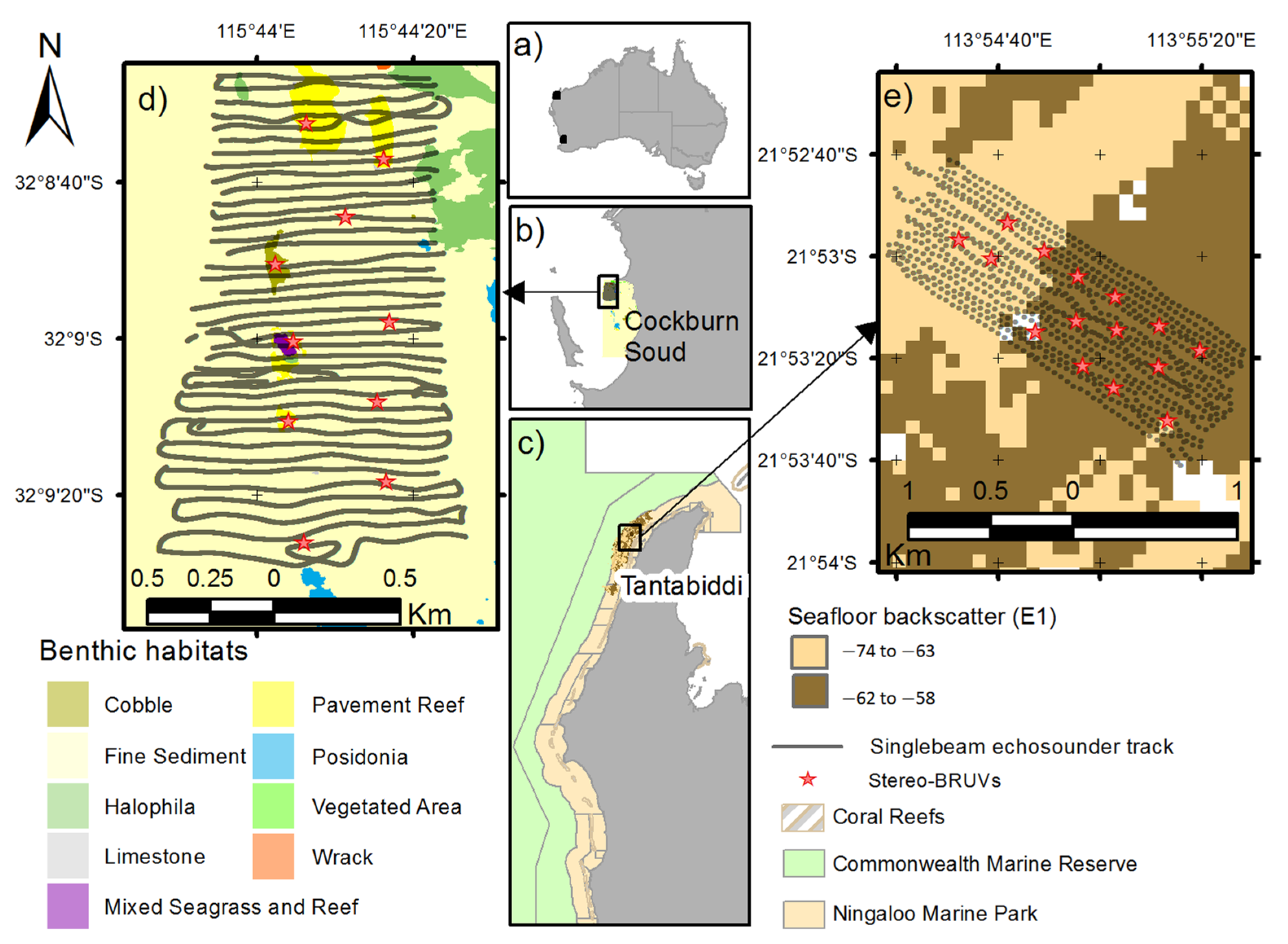

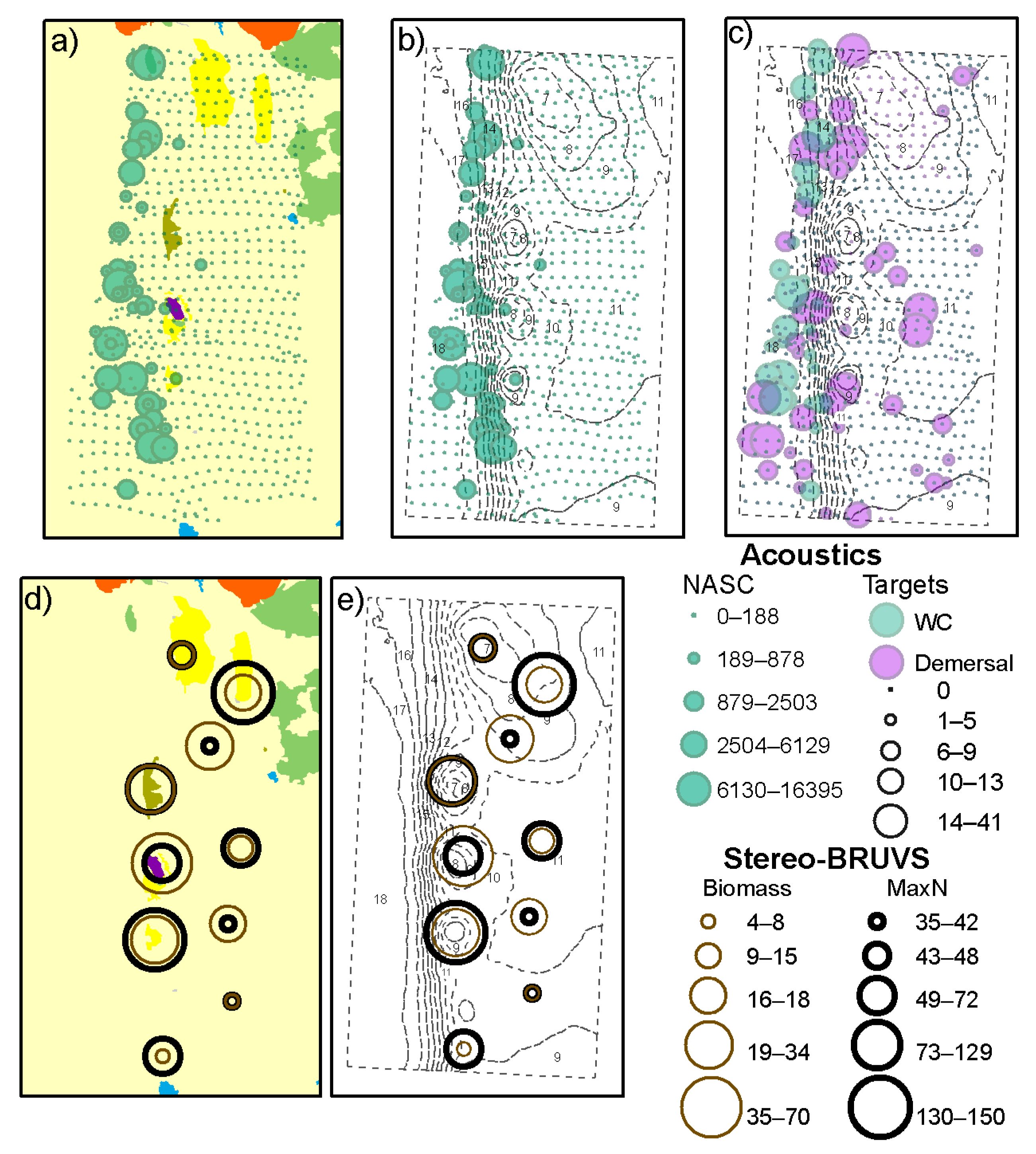
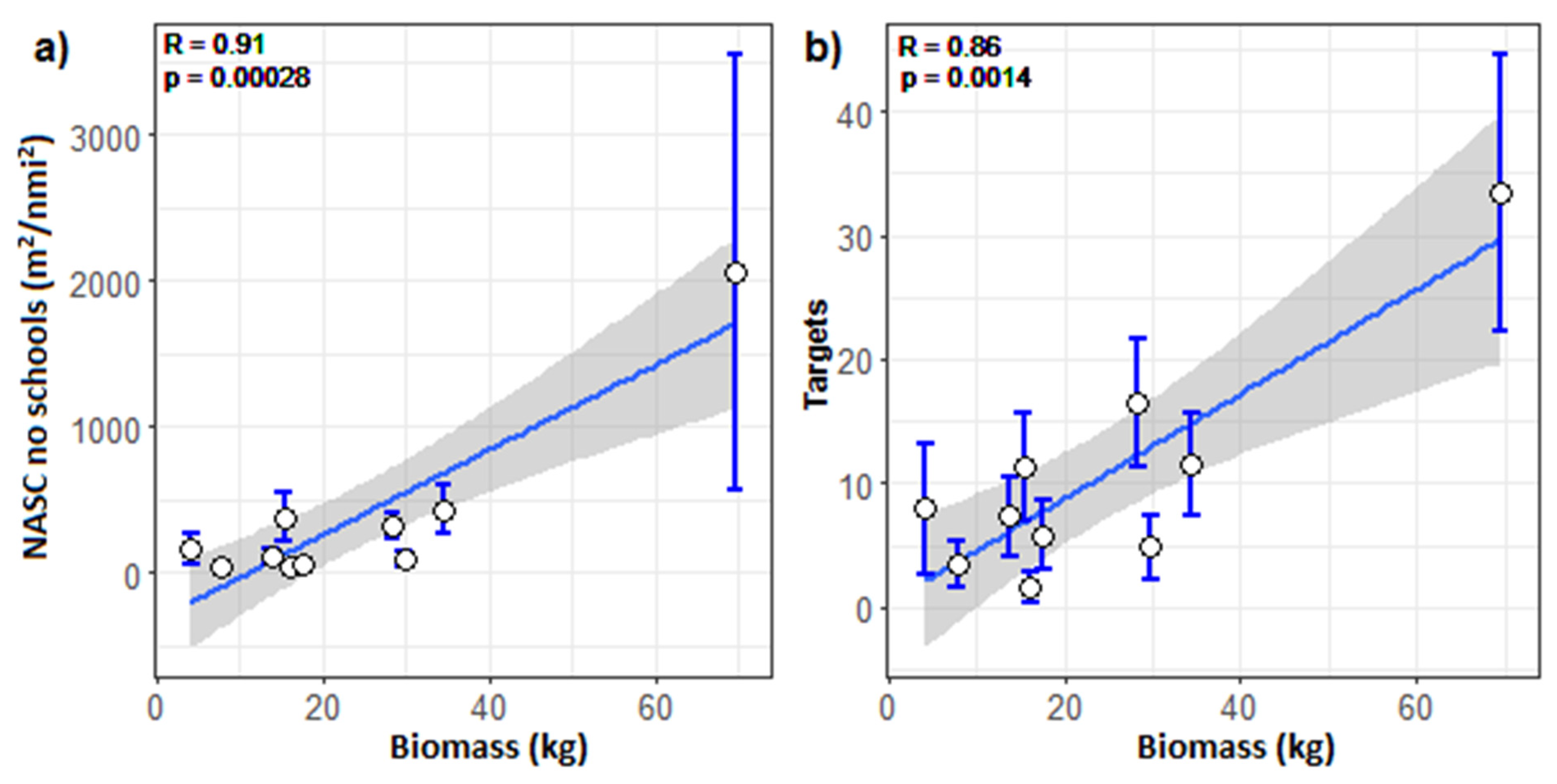
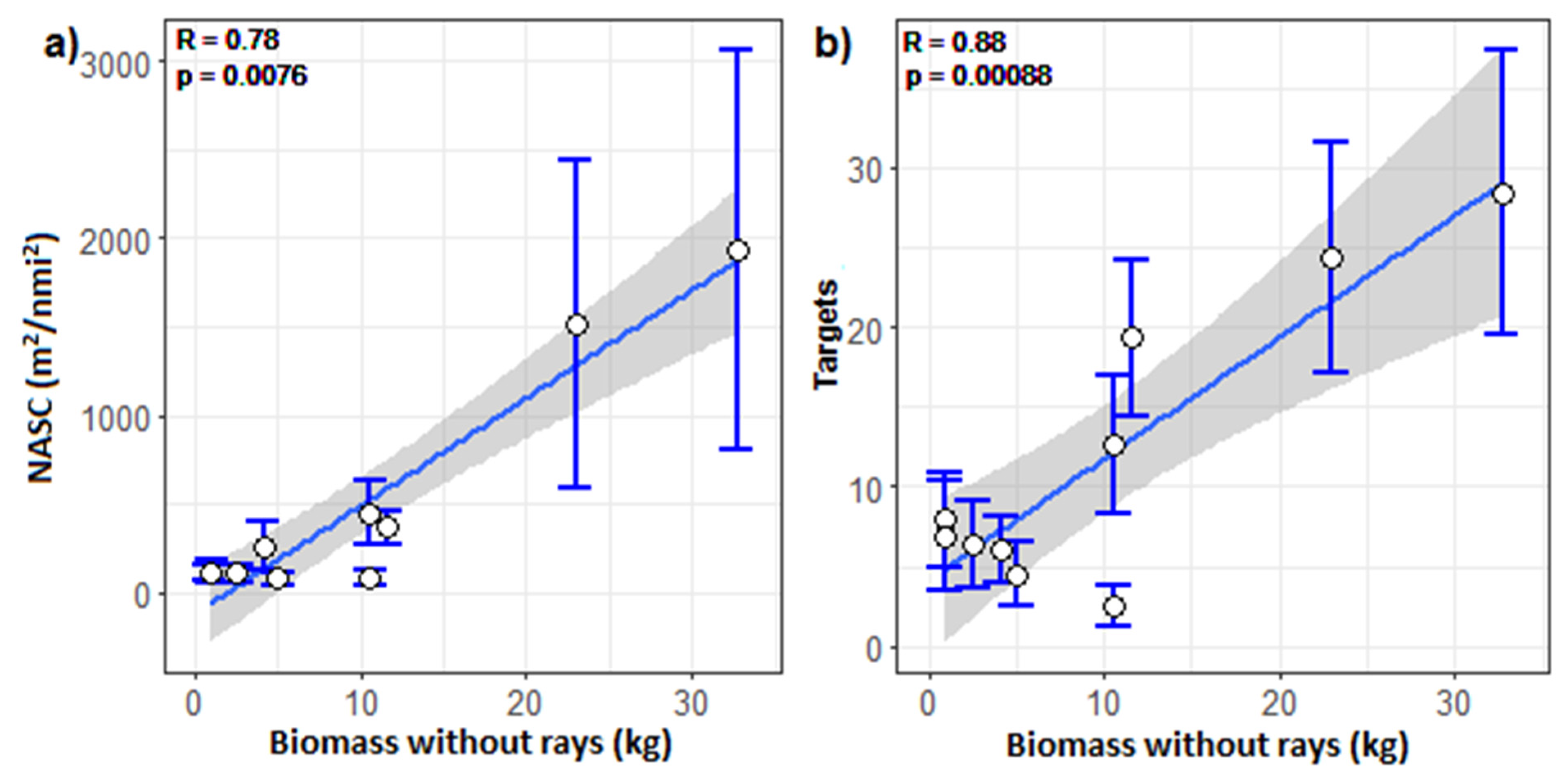
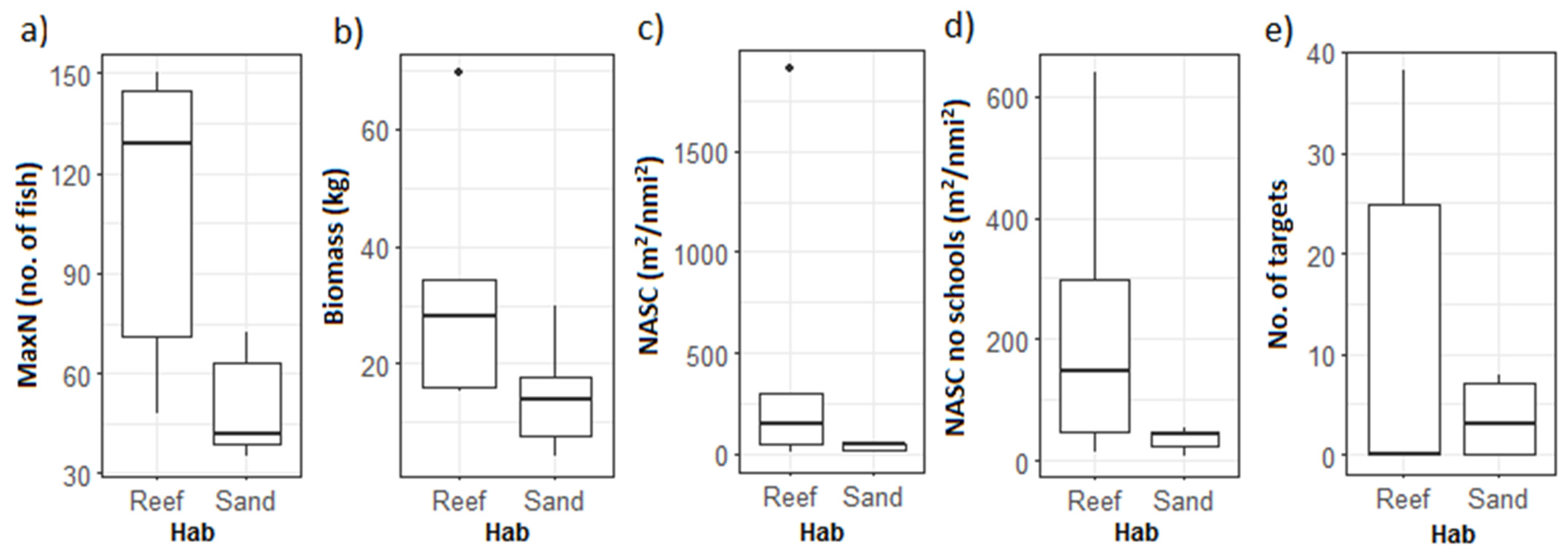
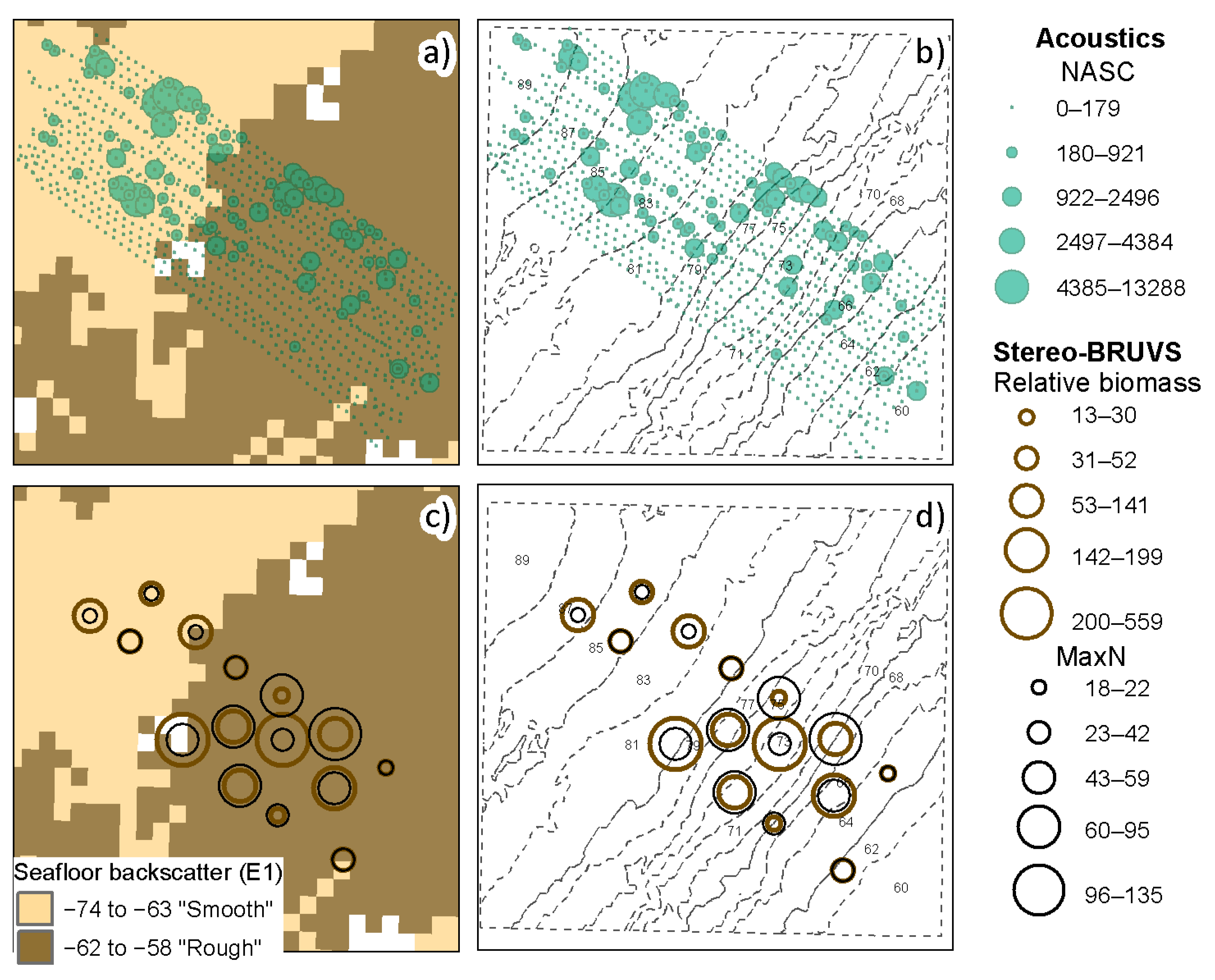
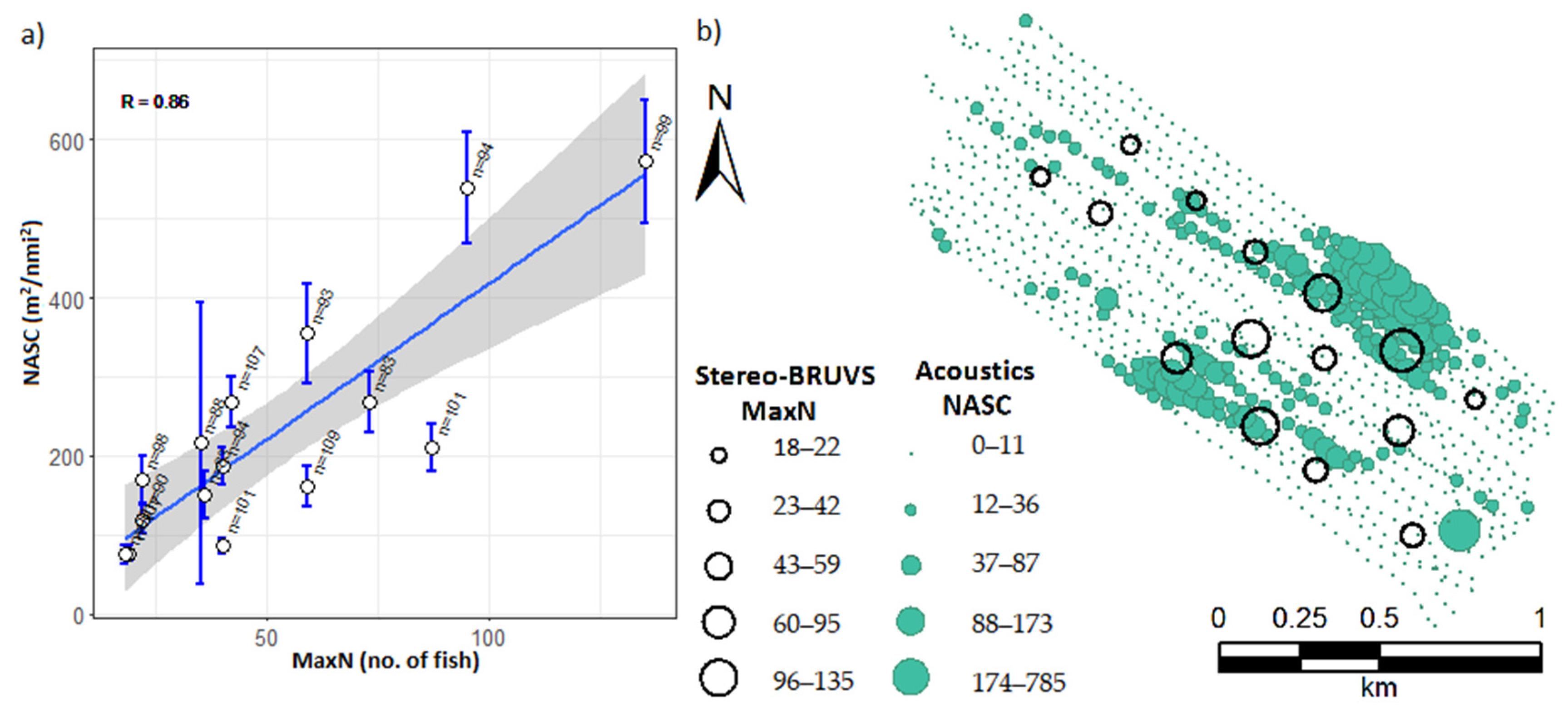
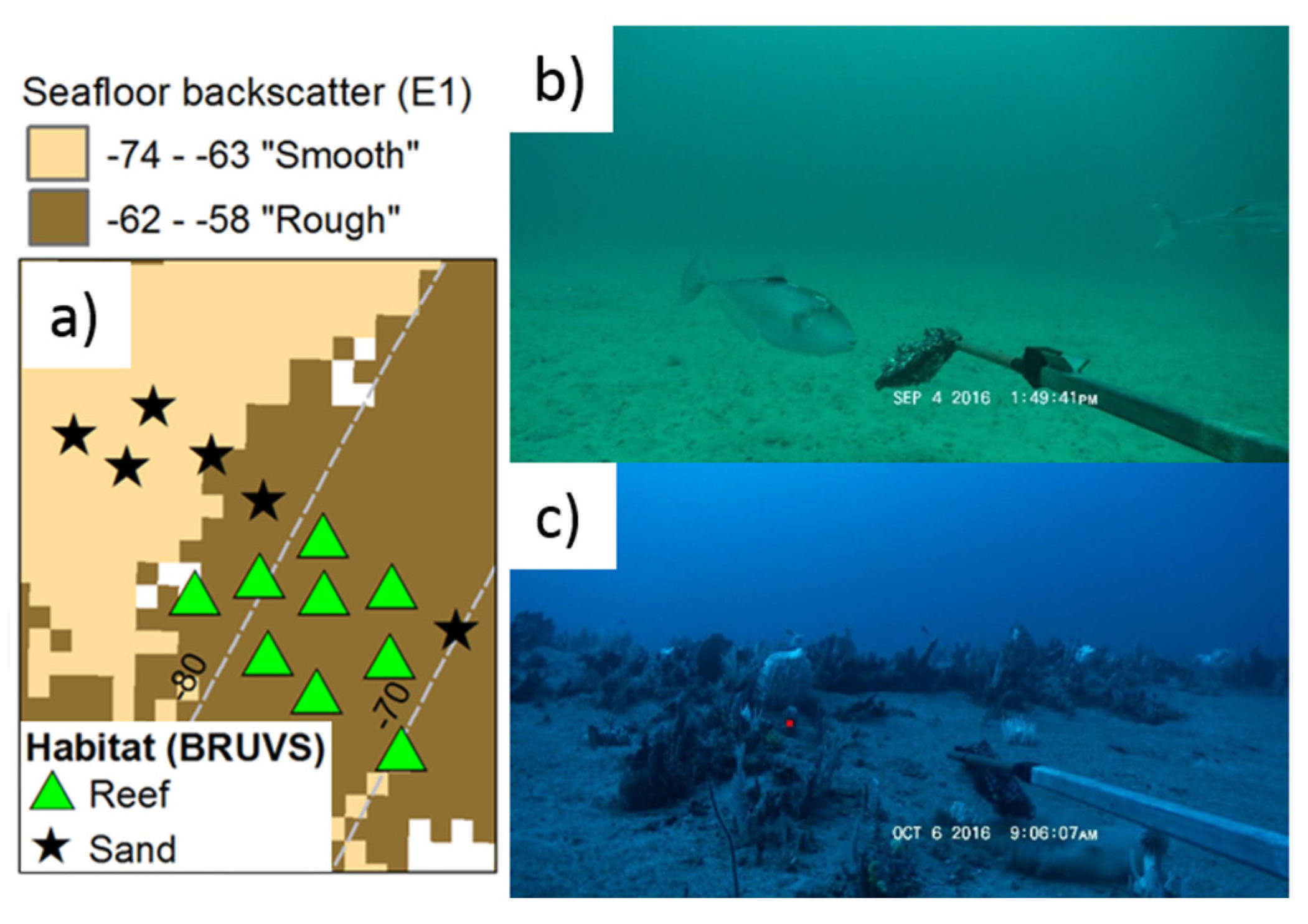
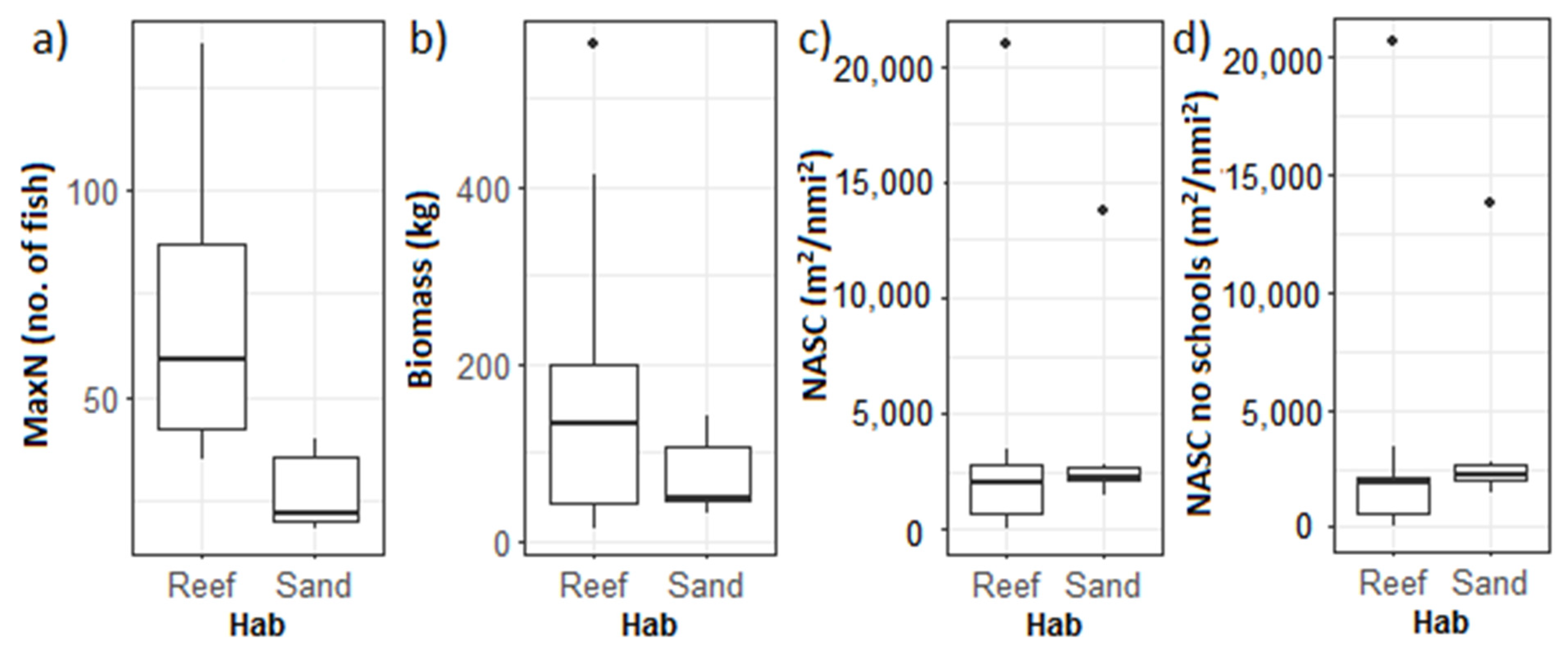

| Frequency | Beam Width | NMP | Cockburn Sound | ||
|---|---|---|---|---|---|
| Pulse Length | Ping Rate | Pulse Length | Ping Rate | ||
| (kHz) | (°) | (ms) | (Pings s−1) | (ms) | (Pings s−1) |
| 38 | 9.8 | 0.8 | 1.9 | 0.3 | 9.2 |
| 120 | 7.8 | 0.5 | 1.9 | 0.2 | 9.2 |
| 420 | 6.8 | 0.5 | 1.9 | 0.1 | 9.2 |
| Study Site | Depth | Benthic Habitats | Acoustics | Stereo-BRUVs | |||||
|---|---|---|---|---|---|---|---|---|---|
| Min | Max | NASC | Biomass (kg) | MaxN | |||||
| Min | Max | Min | Max | Min | Max | ||||
| Cockburn Sound | 7 | 17 | Fine sediment/rocky reef/seagrass | 0–188 | 6130–16,395 | 4–8 | 35–70 | 35–42 | 130–150 |
| Ningaloo Marine Park | 60 | 90 | Bare sand/soft corals/sponges | 0–179 | 4385–13,288 | 13–30 | 200–559 | 18–22 | 96–135 |
| Benthic Classification | Method | Variable | Power | W | p | |
|---|---|---|---|---|---|---|
| Full water column | Soft/hard n = 11; n = 4 | Stereo-BRUVs | MaxN | 0.88 | 4 | 0.0220 |
| Biomass | 0.19 | 22 | 1.00 | |||
| Acoustics | NASC | 0.11 | 30 | 0.34 | ||
| NASCno | 0.11 | 32 | 0.23 | |||
| Targets | 0.38 | 10 | 0.13 | |||
| Sand/reef n = 9; n = 6 | Stereo-BRUVs | MaxN | 0.86 | 4 | 0.0078 | |
| Biomass | 0.30 | 21 | 0.53 | |||
| Acoustics | NASC | 0.05 | 34 | 0.46 | ||
| NASCno | 0.04 | 37 | 0.27 | |||
| Targets | 0.05 | 17 | 0.25 | |||
| Water column excluding 40.5 m above the seafloor | Soft/hard n = 11; n = 4 | Acoustics | NASC | 0.462 | 12 | 0.23 |
| NASCno | 0.46 | 12 | 0.23 | |||
| Sand/reef n = 9; n = 6 | NASC | 0.209 | 20 | 0.46 | ||
| NASCno | 0.199 | 20 | 0.46 |
Publisher’s Note: MDPI stays neutral with regard to jurisdictional claims in published maps and institutional affiliations. |
© 2022 by the authors. Licensee MDPI, Basel, Switzerland. This article is an open access article distributed under the terms and conditions of the Creative Commons Attribution (CC BY) license (https://creativecommons.org/licenses/by/4.0/).
Share and Cite
Landero Figueroa, M.M.; Parsons, M.J.G.; Saunders, B.J.; Parnum, I.M. The Spatial Variation of Acoustic Water Column Data and Its Relationship with Reef-Associated Fish Recorded by Baited Remote Underwater Stereo-Videos off the Western Australia Coast. J. Mar. Sci. Eng. 2022, 10, 52. https://doi.org/10.3390/jmse10010052
Landero Figueroa MM, Parsons MJG, Saunders BJ, Parnum IM. The Spatial Variation of Acoustic Water Column Data and Its Relationship with Reef-Associated Fish Recorded by Baited Remote Underwater Stereo-Videos off the Western Australia Coast. Journal of Marine Science and Engineering. 2022; 10(1):52. https://doi.org/10.3390/jmse10010052
Chicago/Turabian StyleLandero Figueroa, Marcela Montserrat, Miles J. G. Parsons, Benjamin J. Saunders, and Iain M. Parnum. 2022. "The Spatial Variation of Acoustic Water Column Data and Its Relationship with Reef-Associated Fish Recorded by Baited Remote Underwater Stereo-Videos off the Western Australia Coast" Journal of Marine Science and Engineering 10, no. 1: 52. https://doi.org/10.3390/jmse10010052






